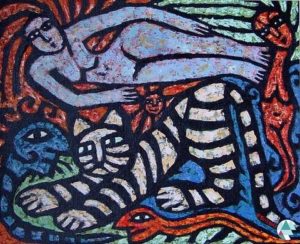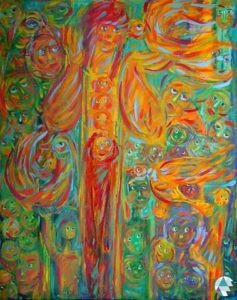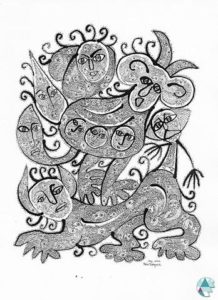by Dr. Alexandra Rodda
As we turn the pages of this book we enter a strange world where the artist’s vision is so different from their perception of the average person.
We are surprised by the juxtaposed position of the naive beauty of a childlike philosophy with the masterly execution of a mature artist. With magical skill, with his precise and personal style, the artist guides our feelings through an efflorescence of images whose roots are in folk-art from many parts of the world.
Page after page we travel, following the strange but sure lines which form a variety of delicately told stories. Each story needs to be unraveled bit by bit.
The artist’s mind seems confused – there is no beginning and there is no end. Not for him the neatly defined, comforting classical parameters, for he has dissolved those boundaries and perceived beyond them an ever changing, seamless and endless reality. We recognise the images the Samsara of eastern philosophers – the ever changing universe of illusory plurality wherein we are subject to generation, mutation, annihilation and regeneration. With a shock, we realize that this form represents stark realism and a very profound level – that there cannot be a tidy closure of the evolution of consciousness.
Felix is deeply involved in his world of images, which spread wider and wider in the multitude of his drawings. Every detail of his drawings are filled with the meticulously told story of his insights into life. Like a laborious ant, he builds up a labyrinth of love, hate, heroism and passivity, hope and despair, bathos and pathos. Everyday experiences acquire a numerous import as they are graphically captured on paper.
We become aware that there is more than meets the eye. Felix’s work can be compared to a script which remains obscure until the graphologist uses the key of a symbolic transformation of images. Dreams, memories and unconscious are the foundations of a very personal artistic expression. The relationship between the artist and the world around him is very intimate. Past and present are closely interwove. The multitude of faces staring from the drawings belong to people surrounding Felix: his wife Danuta, his friends, himself. There are hundreds of eyes looking attentively from tiny faces – some are human, some animal, big and small. They are all very inquisitive. This imaginary world is trying to communicate much more than is at first apparent.
We need to look beyond the technique, beyond the first layer of two dimensional images. A search for an individual expression can take a long time, but it inevitably leads to a very personal and identifiable style. Artistic creativity is a symbolic iconography, a personal approach to the object through the medium of artistic transformation. Creative expression is affected by the artist’s personal life, social inspiration and creative isolation as well as by a wide range of experiences such as illness and social or emotional upheavals.
Felix’s experiences have taken him outside the norm, to truths which few of us would dare or wish to face. Like Arjuna, he has been granted a cosmic vision. He has seen the awful mouths and teeth and stomachs of the universe, and like him he longs to behold the comfortable human face of God.
Nature in its abundance is a particularly strong inspiration for Felix. He always finds some element which will ignite his inspiration: animals, birds, trees, clouds in the sky. During his recent stay on the Gold Coast he was fascinated by the palm trees – this prompted the beginning of a new series of drawings titled ‘The trees of Coolangatta.’ The tropical landscape takes on a new dimension when seen with the artist’s eye.
One of the more commonly encountered elements in Felix’s work is the naked human body. Nude women symbolize the erotic side of his nature. He loved his mother, who had sacrificed her life for her children, more than can be expressed. He loves his sister Tola, and his wife, Danuta.
Nude men are memories of his youth, spent in a German concentration camp, where men were just numbers trying to survive.
The naive surrealism in Felix’s art appears as a fitting vehicle for the simultaneous expression of both his free, transcending spirit and his suffering.
Two very important events in Felix’s life which affected his work were his decision to withdraw from all his business affairs and his subsequent meetings with his present wife, Danuta.
This period in his life is well described by Dorothy Baker, a painter/writer , ex president of the Victorian Artists’ Society in her opening address at Felix’s exhibition in 1987.
…”During this last year something happened to Felix, whether he was upset by something, or he had something wonderful happen, only Felix knows. It released an avalanche inside him, almost crying the work poured out, faces, faces, faces and more faces.
Each of these works full of impulse and power each existing independently, at the same time relating to each other.
To understand the expressive power of these works, we must approach the pictures along the same path as the artist, for only in this way can be experienced, the compulsion striving to express the inner emotion, one who sees things mostly from the mind, and in setting them down reshape our world for us.
Such artist make us reassess things we have taken for granted.
You will recognise the artist’s spiritual coming to terms with his deeply hidden private world. Felix has moved to an active and creative period, he has found his path. We could, in the future see his work of unbelievable importance. These present works will, in time, become historic as the beginning of a series he has already commenced.”
In his art Felix went back to using strong, expressionist techniques acquired during the period of his studies under Donald Campbell.
Felix’s paintings became more powerful and the use of symbolism became more evident. Red became a dominant colour in his works which were very austere. Faces and eyes appeared to float obsessively through spaces filled with strong, often dissonant colours. It was like a scream suppressed for many years, followed by the discovery of artistic liberation.
During this time Felix developed breathing difficulties which were treated as asthma for a long time. With a correct diagnoses came a coronary bypass operation. On the fourth post operative day, the doctors gave up hope as he appeared to be setting out on his last journey.
However, it was not to be. Miraculously, he escapes death for the second time in his life and returned to the land of the living. After the operation, being as yet unfit for the vigorous physical exertion of painting, his artistic drive found a new channel of expression – a drawing pen. No more vibrant colour, but a stern black and white.
In his very first attempts Felix used a stick found in the park.
Then fine drawing pens were given to him by his artist friend Gunnar Neeme. Finally, persuaded by Bill Coleman he bought professional drawing pens. Drawing became a real passion. The drawing exhibitions of Felix were a big success.
Without further introduction, let us wander through this strange world of artistic expression which welds the past and the present into an inseparable one. Let us experience this stream of expressivity without beginning or end. We can confidently expect to be intrigued and affected, but never to remain indifferent.
Dr. Alexandra Rodda
Gallery Curator:Felix online gallery can be explored here.




















